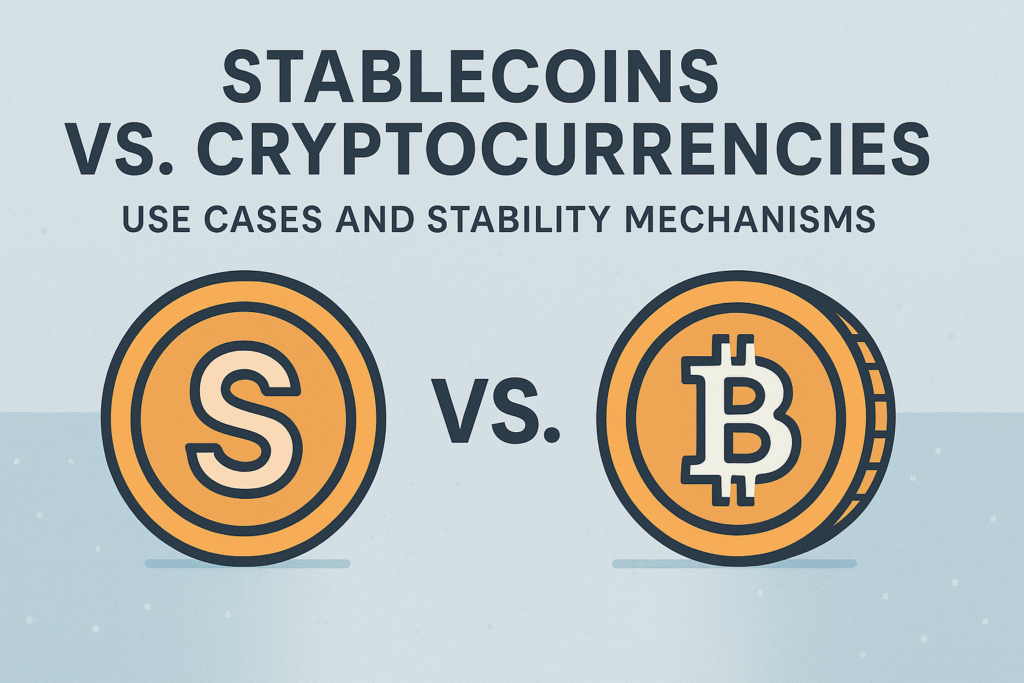Introduction
Cryptocurrencies and stablecoins occupy overlapping but distinct parts of the digital-asset ecosystem. Cryptocurrencies like Bitcoin and Ether are designed primarily as decentralized stores of value, means of exchange, or platforms for programmable finance; they tend to be volatile because their market prices reflect speculation, adoption, and network fundamentals. Stablecoins, by contrast, are tokens engineered to maintain a stable value—most commonly pegged to a fiat currency such as the U.S. dollar—so they can serve use cases that require low price volatility. Understanding how each is used and how stability is achieved helps clarify their roles, risks, and the trade-offs they present.
Core differences
– Purpose
– Cryptocurrencies: designed as investment assets, native currencies for blockchain networks, or utility tokens for apps and smart contracts.
– Stablecoins: designed to minimize price fluctuation and act as a medium of exchange, unit of account, and bridge between fiat and crypto.
– Volatility
– Cryptocurrencies: high volatility, which can enable outsized returns but also large losses.
– Stablecoins: low volatility relative to fiat peg; success depends on mechanism and market confidence.
– Governance and issuance
– Cryptocurrencies: issuance and governance usually determined by protocol rules and community decisions.
– Stablecoins: often issued by companies or governed by specific protocols; governance can be centralized (issuer controls reserves) or decentralized (governance tokens manage protocol parameters).
Common use cases
– Payments and remittances
Stablecoins enable faster, cheaper cross-border transfers than many traditional systems, particularly when on-chain rails and low fees exist.
– On- and off-ramps
Stablecoins bridge fiat and crypto: users can move value on-chain without immediately reconverting to fiat, simplifying access to DeFi and exchanges.
– Trading and liquidity
Traders use stablecoins as a stable counterbalance to volatile positions and as a base asset for trading pairs on centralized and decentralized exchanges.
– Decentralized finance (DeFi)
Stablecoins are essential for lending, borrowing, yield farming, collateral, and pricing of synthetic assets because predictable value simplifies protocol design and risk management.
– Store of value within crypto environments
During market turbulence, investors often park funds in stablecoins to avoid realizing losses or exiting the crypto ecosystem.

– Treasury and corporate use
Businesses and DAOs can hold stablecoins on-chain to pay contributors, settle contracts, or manage liquidity in a programmable way.
Stability mechanisms: how stablecoins maintain a peg
Stablecoins typically use one or more of the following mechanisms to keep their price close to a target value.
1. Fiat-backed (off-chain collateralized)
– How it works: Issuers hold fiat currency (USD, EUR, etc.) or cash-equivalents in bank accounts or custodial arrangements; each token is redeemable 1:1 for the underlying fiat.
– Examples: USDC, BUSD, historically many commercial stablecoins.
– Strengths: Intuitive and simple; peg maintained through direct redemption for fiat; low price slippage.
– Risks: Counterparty risk (bank solvency), regulatory risk, centralization, and the need for transparent reserves and audits.
2. Crypto-backed (on-chain collateralized)
– How it works: Stablecoins are overcollateralized with other crypto assets deposited in smart contracts. Collateralization ratios are set above 100% to absorb volatility. Automatic liquidation or auction mechanisms protect the peg when collateral value falls.
– Examples: DAI (collateralized by various crypto assets), some variants of wrapped or collateralized tokens.
– Strengths: Transparency (on-chain collateral), censorship resistance, compatibility with DeFi composability.
– Risks: Collateral volatility can trigger liquidations and destabilize the peg during market stress; complex governance; requires sufficient overcollateralization which reduces capital efficiency.
3. Algorithmic (non-collateralized or partially collateralized)
– How it works: Software protocols adjust supply or use smart contracts/market mechanisms to keep price near peg. Mechanisms include rebasing (changing supply in wallets), seigniorage-style token minting/burning, and incentivized arbitrage (issuance and redemption at specific prices).
– Examples: Historically attempted by multiple projects; notable failure of UST/LUNA showed fragility of some designs.
– Strengths: Potentially more capital efficient and decentralized if well-designed.
– Risks: Vulnerable to runs and loss of confidence; attacks during liquidity crunches; complex incentive alignment; has proven fragile in practice when not adequately collateralized.
4. Commodity-backed
– How it works: Tokens are backed by physical assets (gold, oil, real estate). Redemption rights, custodial arrangements, and valuation methods determine stability.
– Examples: Tokenized gold coins/tokens.

– Strengths: Tangible reserve assets; alternative to fiat or crypto collateral.
– Risks: Custody and audit concerns, valuation and liquidity of the underlying asset, regulatory complexity.
5. Hybrid models
– How it works: Combine elements above—partial fiat reserves, crypto collateral, governance mechanisms, and algorithmic features—to balance decentralization with stability.
– Examples: FRAX (hybrid collateral and algorithmic adjustments), other multi-reserve stablecoins.
– Strengths: Potential to reduce single-point failures and improve capital efficiency.
– Risks: Added complexity and coordination challenges; still subject to the failure modes of constituent mechanisms.
Mechanisms to maintain peg in practice
– Redemption at par: Users redeem tokens for the underlying asset (fiat or collateral), which reinforces the peg through arbitrage.
– Arbitrage incentives: When the stablecoin trades off-peg, arbitrageurs buy undervalued coins and redeem them or sell overvalued coins for profit, pushing price back to peg.
– Collateral liquidation and auctions: Crypto-collateralized systems liquidate undercollateralized positions into auctions to preserve solvency.
– Market-making and treasury operations: Issuers or DAOs deploy reserves to provide liquidity and defend the peg during stress.
– Algorithmic supply adjustments: Protocols mint or burn supply or offer bonds/LP tokens to absorb supply shocks.
Risks and failure modes
– Reserve opacity and fraud: Lack of transparent, timely audits can hide insufficient reserves or risky reserve composition.
– Counterparty and custody risk: Fiat-backed stablecoins depend on banks and custodians; these institutions can fail, face sanctions, or lose access to payment rails.
– Smart contract risk: Vulnerabilities in code can lead to exploits and loss of collateral.
– Liquidity and market risk: Sudden market moves can render collateral insufficient, triggering cascading liquidations.
– Run risk (particularly algorithmic models): A loss of confidence can prompt mass redemptions or selling, exceeding the mechanisms’ capacity to restore the peg.
– Regulatory action: Governments can restrict issuance, impose heavy compliance requirements, freeze addresses, or treat stablecoins as regulated money or securities.
– Centralization vs decentralization trade-offs: More centralized designs are easier to maintain but introduce single points of control; decentralized designs may be more censorship-resistant but harder to defend in crisis.
Regulatory and compliance considerations

– Money transmission laws: Issuers may need licenses depending on jurisdiction and services offered.
– Reserve transparency and audits: Regulators and users increasingly demand regular attestations, audits, and public disclosures of reserve composition.
– AML/KYC: On-ramps and many issuers implement anti-money-laundering and know-your-customer controls, particularly for fiat-backed stablecoins.
– Stablecoin-specific regulation: Several jurisdictions have proposed or enacted rules governing stablecoin issuance, reserve standards, redemption rights, and consumer protection.
– Tax and reporting obligations: Use of stablecoins can trigger tax reporting depending on local law.
How to choose and use stablecoins safely
– Assess transparency: Prefer issuers with regular audits or on-chain verifiable reserves.
– Know the peg mechanism: Understand whether a coin is fiat-backed, crypto-backed, algorithmic, or hybrid and the associated risks.
– Consider counterparty risk: For custodial stablecoins, evaluate the issuer’s custodians, banking partners, and legal jurisdiction.
– Use case matching: For high-assurance business payments, fiat-backed, well-audited stablecoins may be appropriate; for DeFi composability, crypto-collateralized or algorithmic options may be necessary but riskier.
– Diversify: Holding multiple stablecoins can reduce exposure to a single issuer or design failure.
– Keep security hygiene: Use trusted wallets, hardware wallets for custody, and follow best practices for private key management.
Future outlook
– Central bank digital currencies (CBDCs) will coexist with private stablecoins, potentially reshaping payments and regulatory frameworks.
– Improved transparency standards, reserve frameworks, and custody solutions are likely, driven by both industry and regulators.
– Research into more robust algorithmic designs and hybrid models may continue, but market confidence will remain a key determinant of success.
– Tokenization of real-world assets and integration with regulated financial services will expand stablecoins’ utility but also complicate compliance.
– The tension between decentralization and regulatory/commercial practicality will drive continued innovation and consolidation in the stablecoin space.
Conclusion
Stablecoins are a pragmatic response to cryptocurrency price volatility, enabling payments, liquidity, and DeFi activity by maintaining a peg to a stable reference value. They achieve stability through various means—fiat reserves, crypto collateral, algorithms, commodities, or hybrids—each with distinct strengths and vulnerabilities. Choosing the right stablecoin requires aligning use case needs with an understanding of the underlying mechanism, transparency, and counterparty risks. As regulation, auditing practices, and technological designs evolve, stablecoins will likely remain a central element of digital finance, bridging traditional and blockchain-native systems.
Disclaimer: This article provides general information and is not financial, legal, or investment advice.

